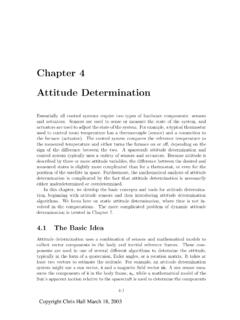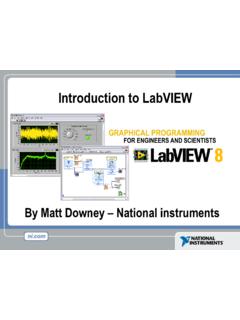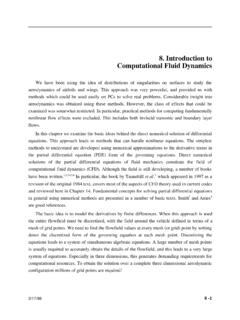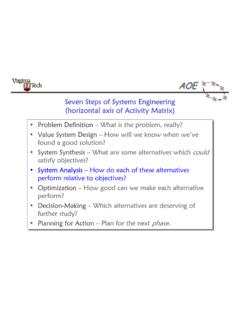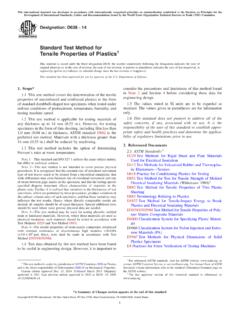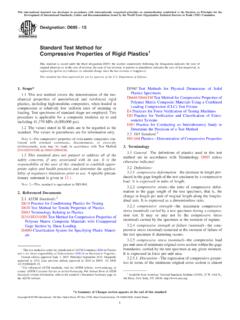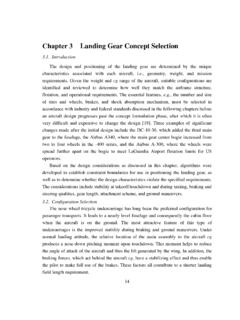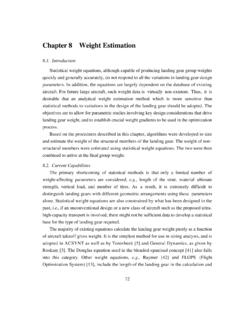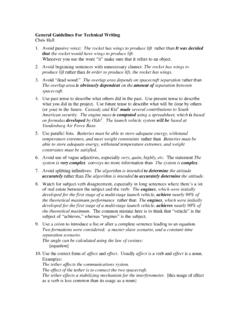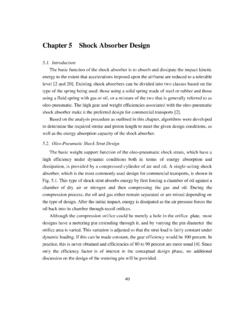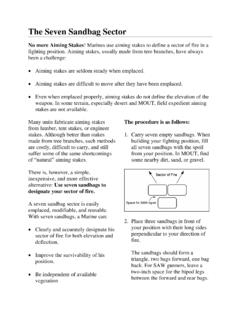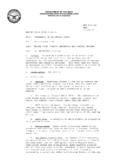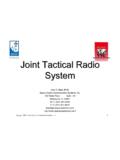Transcription of Boeing X-32 Lockheed Martin X-35 - Virginia Tech
1 JOINT STRIKE FIGHTER. Boeing X-32. Lockheed Martin X-35. Geoffrey Buescher 23 April 2001. 1. History Harrier CALF. From Joint Strike Fighter, Bill Sweetman JAST JSF. space/military/jsf/images/X- The Marine Corps and Royal Navy, among several other navies, recognized the advantages of STOVL when they adopted the Harrier. A. follow-on was a necessity, as the requirement for a STOVL aircraft has not disappeared since service entry of the Harrier. Some research into STOVL. therefore continued through the 1980s, notably in the Advanced STOVL. project begun by the and in 1986. DARPA had a hand in ASTOVL, and this agency in 1988 developed a requirement with the Navy and Marines for a STOVL aircraft weighing no more than 24 000 lb and occupying no more ground space than an F-18. Although the weight cap was intended to keep cost down, the DARPA requirement was also based on the GE F120 and Pratt & Whitney F119 engines.
2 Design studies made against this requirement focused on reducing hot gas ingestion and improving stealth in up and away flight. -The aging of front line aircraft the F-14, F-16, F-18, and AV-8B and the cancellation of programs intended to replace them, including the A-12, brought the possibility of combining the requirements to save cost. The Marines still needed a STOVL aircraft, while the Air Force needed a relatively lightweight and cheap fighter with fairly long range and good stealth characteristics. The Navy needed a stealthy long-range medium bomber. Despite the dissimilarities in the requirements, the Common Affordable Lightweight Fighter program awarded contracts for a multi-service aircraft to Lockheed Martin and McDonnell Douglas in 1993. Both aircraft used lift fans and internal weapons carriage. The lift fans simultaneously increased mass flow (for added thrust above that at which the gas generators were rated) and provided a cold flow of air shielding the engine inlets from hot-section exhaust 2.
3 At the tail. Requirements RN: 150. STOVL. USMC: 609. STOVL USAF: USN: 480 1763 CTOL. CV. CTOL STOVL CV. Cost $28M $35M $38M. Empty weight Mid-22000 lb Mid-22000 lb Mid-24000 lb Max takeoff weight 50000 lb 50000 lb 50000 lb Internal fuel 15000 lb 15000 lb 16000 lb Payload 13000 lb 13000 lb 17000 lb Range 600 nmi + 600 nmi + 600 nmi +. Air Force: Increased stealth, reliability and range relative to F-16, but performance not necessarily better. Low-end fighter to complement F-22 (as F-16 for F-15); Air Force acquisition executive Arthur L. Money: The F-22. is the force enabler; the JSF is the force (Ref. 2). 1763 aircraft, replacing A- 10 and F-16. (Ref. 2, 3). Navy: Stealthy first day of the war deep-strike medium bomber capable of eliminating high-priority installations and opening a path through air defense systems for F/A-18E/Fs to follow. In this sense, replaces A-6 in lieu of A-12.
4 Must be able to carry two 2000-lb PGMs internally to 600 nmi. For Navy, JSF is high-end complement to F/A-18E/F. CVW mix: 36 F/A- 18E/Fs, 14 JSFs. 480 aircraft, replacing F/A-18C/D. (Ref. 2,3,4). Marine Corps: STOVL strike aircraft for close air support. Quick response capability of AV-8B at increased reliability and speed. 609 aircraft, replacing AV-8B and F/A-18. (Ref. 2, 3, 4). Royal Navy: STOVL strike fighter. 150 aircraft, replacing Harrier. (Ref. 4). Total requirement: 3002 airframes Program office requirements for operational aircraft: as in chart. (Ref. 5). However, these are flexible to achieve the best-value solution. (Ref. 2) Note weights do not sum to max takeoff weight, and note that empty weights specified are less than actual weights of demonstrators (see slide 8). 3. Strongest emphasis is on meeting cost goals: cost is an independent variable Pratt & Whitney JSF119.
5 Pratt & Whitney F119 is used as baseline engine for all JSF airframes from both manufacturers. However, General Electric hopes to present a derivative of its F120 which lost in the competition to power the ATF (F-22/F-23) as competition after the initial block of aircraft. (Ref. 2). Baseline F119 produces 35 000 lb of thrust the JSF119 produces about 40. 000 lb. (Ref. 6). In X-35, JSF119 has produced 25 000 lb dry. (Ref. 7). Above basic F119, JSF119 features: Added prognostic health management system to sense impending failure. JSF119-614 for Boeing airplane, JSF119-611 on Lockheed Martin entry. Low pressure turbine increased from one to two stages, and fan scaled up 10-20%: allows increased airflow and power. (Ref. 8). 4. Competitors Lockheed Martin Boeing . X-35 X-32. 5. Boeing X-32. Original Boeing design retained high fuel-volume delta wing of Boeing CALF concept; mounted high to avoid suckdown from high-velocity exhaust moving along ground in STOVL mode (Ref.)
6 1). Original design: CTOL and CV versions to have the same dimensions, with a leading-edge vortex flap on the leading edge of the Navy version (Ref. 8). 36. ft wingspan, 45 ft long. STOVL to have shorter, 30 ft wingspan. (Ref. 4). Forward-swept chin inlet. 1998 design effort to improve control and maneuverability, reduce weight. Two parallel redesign efforts, one to rework original delta wing, one to try other options; cost of improvements was weighed in considering whether to implement changes. Demonstrator aircraft (X-32s) would not reflect these changes planned for the PWSC (preferred weapon system concept): -Change inlet from forward to aft sweep, allowable because of nosegear redesign. Reduced weight of inlet structure, improved RCS and high-alpha inlet efficiency. -To improve pitch control, wing needed to move aft, but this caused difficulties with balancing, imposing limits on fuel and payload capacities.
7 By reducing wing area, lengthening aircraft by two feet, and adding horizontal tails, necessary pitching moment could be produced without affecting fuel fraction, range, weight, or balance. Trailing edge of wing has full-span flaperon on CTOL version, separate flaps and ailerons on CV version also a leading edge flap forward of the aileron. (Ref. 9) Vertical tail redesigned also same area, but reshaped. 6. -Carrier approach speed reduced by 2 kt as a result of changes. Changes also Boeing STOVL 3-Post Direct Lift System Forward-mounted engine Translating cowl Roll-control ducting and nozzles Yaw control nozzles Pitch control nozzles Pitch-vectoring nozzle aft Vectoring Harrier-type nozzles amidships Boeing concept uses Harrier-type vectoring nozzles at center of gravity, vectoring main nozzle that can be directed downward. Auxiliary nozzles provide fine control of pitch, yaw, and roll.
8 An additional nozzle forward of the swiveling nozzles provides a cold flow to screen the inlet from the hot exhaust gases aft. The cowl translates forward to increase area for higher airflow during high-thrust requirement STOVL operation. (Ref. 1, 2). In up and away flight, midbody nozzles are covered with doors to improve observability. (Ref. 8). Concept has been proven on Harrier, but still considered high-risk (Ref. 1, Ref. 2) I don't entirely understand this. It is said that many things have to go right for it to work. Propbably this refers to the limited thrust capability of the concept, unaugmented by a lift fan. 7. Lockheed Martin X-35. From Jane's All the World's Aircraft 2000-2001, Paul Jackson editor, p. 702. X-35 design reminiscent of F-22, but smaller and with only a single engine Notable feature: diverterless inlets with no moving parts: instead, a bump on the inlet wall splits the boundary layer apart and the sawtooth inlet captures clean airflow while the boundary layer slides around the upper and lower edges.
9 Concept is a risk, but has flown at Mach 2 on a modified F-16. (Ref. 1, 11). CTOL and STOVL aircraft of the same dimensions, 35 ft wingspan, ft length; CV aircraft larger, 43 ft wingspan, ft length. (Ref. 2). Aircraft planned for production very similar to demonstrator aircraft. A. higher-performance version with a larger wing was planned, but the extra capability was not needed, so the smaller, lighter, cheaper wing was selected for production. Wing area of the production CTOL version will be 412 ft 2. (compared to 450 ft2 for the demonstrator), while the CV version will have 600. ft2 of wing area (versus 540 ft2 on the demonstrator). (Ref. 11, 12). CV version longer range (~100 nmi), lands slower (10 15 kt), but rolls and accelerates more slowly than the CTOL and STOVL versions. In the development of the production airplane, the high-lift devices and trim will be adjusted to produce similar performance in the carrier-based aircraft relative to the land-based ones; the extra effort will be reflected in extra cost for the carrier-based version.
10 (Ref. 12) It is not clear to me how acceleration can be improved without uprating the engine or drastically reducing the drag enough to require significant configuration changes. Weights: X-35A, 26 500 lb; X-35B, 30 697 lb; X-35C 30 618 lb (Ref. 4) 8. Lockheed Martin STOVL Lift Fan System 60% thrust boost from increased bypass ratio Smaller inlets for supersonic flight Aft engine location better than forward for observability, supersonic concerns three-bearing nozzle, as on Yak-141, rotates 90 deg from aft (cruise) position) to pointing down for vertical landing. Clutch at lift fan couples F119 low pressure shaft to lift fan. Lift fan has two stages, pressure ratio of 2. Uses 27 000 28 000 hp from 70 000 80 000. produced by turbine. (Ref. 7). Using lift fan instead of hot flow reduces flow velocity by 30%, lowers temperature by 250 deg F; lift fan produces about 18 000 lb thrust.
